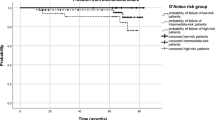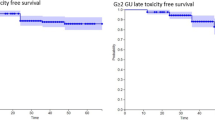Abstract
Purpose:
To report acute and late toxicity in prostate cancer patients treated by high-dose intensity-modulated radiation therapy (IMRT) with daily image-guidance.
Patients and Methods:
From 06/2004–03/2008, 102 men were treated with 80 Gy IMRT with daily image-guidance. The risk groups were as follows: low, intermediate, and high risk in 21%, 27%, and 52% of patients, respectively. Hormone therapy was given to 65% of patients. Toxicity was scored according to the CTC scale version 3.0.
Results:
Median age was 69 years and median follow-up was 39 months (range, 16–61 months). Acute and late grade 2 gastrointestinal (GI) toxicity occurred in 2% and 5% of patients, respectively, while acute and late grade 3 GI toxicity was absent. Grade 2 and 3 pretreatment genitourinary (GU) morbidity (PGUM) were 15% and 2%, respectively. Acute grade 2 and 3 GU toxicity were 43% and 5% and late grade 2 and 3 GU toxicity were 21% and 1%, respectively. After multiple Cox regression analysis, PGUM was an independent predictor of decreased late ≥ grade 2 GU toxicity-free survival (hazard ratio = 9.4 (95% confidence interval: 4.1, 22.0), p < 0.001). At the end of follow-up, the incidence of late grade 2 and 3 GU toxicity decreased to 7% and 1%, respectively.
Conclusion:
GI toxicity rates after IMRT with daily image-guidance were excellent. GU toxicity rates were acceptable and strongly related to PGUM.
Zusammenfassung
Ziel:
Beschreibung der Akut- und Spätnebenwirkungen bei Patienten mit Prostatakarzinom, die mit intensitätsmodulierter Hochdosis- Radiotherapie (IMRT) und täglicher Image Guidance behandelt wurden.
Patienten und Methodik:
Von 06/2004 bis 03/2008 wurden 102 Männer mit 80 Gy IMRT behandelt. Die Zuordnung zu Risikogruppen ergab: niedrig bei 21%, mittelhoch bei 27% und hoch bei 52% der Patienten. Hormontherapie erhielten 65% der Patienten. Die Toxizität wurde anhand der CTC Kriterien Version 3.0 bestimmt.
Ergebnisse:
Das mediane Alter betrug 69 Jahre und die mediane Nachbeobachtungszeit war 39 Monate (Spannbreite, 16–61 Monate). Akute und späte Grad-2-gastrointestinale (GI) Nebenwirkungen traten in 2% und 5% der Fälle auf; akute oder späte Grad-3-GI Nebenwirkungen wurden nicht beobachtet. Die Grad-2- und -3-urogenitale (GU) Morbidität, welche bereits vor IMRT bestand (PGUM), betrug 15% und 2%. Akute Grad-2- und -3-GU Nebenwirkungen lagen bei 43% und 5% und späte Grad-2- und -3-GU Nebenwirkungen bei 21% und 1%. In der multiplen Cox Regressionsanalyse erwies sich PGUM als unabhängiger Prädiktor für ein verkürztes (spät) ≥ Grad-2-GU nebenwirkungsfreies Überleben (hazard ratio = 9.4 [95% confidence interval: 4.1, 22.0], p < 0.001). Am Ende des Nachbeobachtungszeitraumes sank die Inzidenz von späten Grad-2 und -3-GU Nebenwirkungen auf 7% und 1%.
Schlussfolgerung:
Die GI Nebenwirkungsrate nach IMRT mit täglicher Image Guidance war exzellent. GU Nebenwirkungsraten waren akzeptabel und standen in engem Zusammenhang den urogenitalen Beschwerden vor Radiotherapie.
Similar content being viewed by others

References
Al-Mamgani A, van Putten WL, Heemsbergen WD, et al. Update of Dutch multi center dose-escalation trial of radiotherapy for localized prostate cancer. Int J Radiat Oncol Biol Phys 2008;72:980–8.
Cahlon O, Zelefsky MJ, Shippy A, et al. Ultra-high dose (86.4 Gy) IMRT for localized prostate cancer: toxicity and biochemical outcomes. Int J Radiat Oncol Biol Phys 2008;71:330–7.
Cox DR, Oakes D. Analysis of survival data. London, United Kingdom: Chapman and Hall, 1984;110–20.
Dearnaley DP, Sydes MR, Graham JD, et al. Escalated-dose versus standarddose conformal radiotherapy in prostate cancer: first results from the MRC RT01 randomised controlled trial. Lancet Oncol 2007;8:475–87.
D’Amico AV, Whittington R, Malkowitcz SB, et al. Biochemical outcome after radical prostatectomy external beam radiation therapy, or interstitial radiation therapy for clinically localized prostate cancer. JAMA 1998;280: 969–74.
Dolezel M, Odrazka K, Vaculikova M, et al. Dose escalation in prostate radiotherapy up to 82 Gy using simultaneous integrated boost. Strahlenther Onkol 2009;186:197-202.
Fonteyne V, Villeirs G, Lumen N, et al. Urinary toxicity after high dose intensity modulated radiotherapy as primary therapy for prostate cancer. Radiother Oncol 2009;92:42–7.
Ghadjar P, Vock J, Vetterli D et al. Acute and late toxicity in prostate cancer patients treated by dose escalated intensity modulated radiation therapy and organ tracking. Radiat Oncol 2008;3:35.
Goldner G, Dimopoulos J, Kirisits C, et al. Moderate dose escalation in threedimensional conformal localized prostate cancer radiotherapy. Strahlenther Onkol 2009;7:438–45.
Guckenberger M, Flentje M. Intensity-modulated radiotherapy (IMRT) of localized prostate cancer: a review and future perspectives. Strahlenther Onkol 2007;183:57–62.
Harris EK, Albert A. Survivorship analysis for clinical studies. New York, NY: Marcel Dekker, 1991;5–125.
Heemsbergen WD, Peeters STH, Koper PCM, et al. Acute and late gastrointestinal toxicity after radiotherapy in prostate cancer patients: consequential late damage. Int J Radiat Oncol Biol Phys 2006;66:3–10.
Kalz J, Sterzing F, Schubert K, et al. Dosimetric comparison of image guidance by megavoltage computed tomography versus bone alignment for prostate cancer radiotherapy. Strahlenther Onkol 2009;185:241–7.
Kessler TM, Burkhard FC, Studer UE. Nerve-sparing open radical retropubic prostatectomy. Eur Urol 2007;51:90–7.
Kuban DA, Tucker SL, Dong L, et al. Long-term results of of the M.D. Anderson randomized dose-escalation trial for prostate cancer. Int J Radiat Oncol Biol Phys 2008;70:67–74.
Kupelian PA, Elshaikh M, Reddy CA, et al. Comparison of the efficacy of local therapies for localized prostate cancer in the prostate-specific antigen era: a large single-institution experience with radical prostatectomy and external-beam radiotherapy. J Clin Oncol 2002;20:3376–85.
Lawton CA, Bae K, Pilepich M, et al. Long-term treatment sequelae after external beam irradiation with or without hormonal manipulation for adenocarcinoma of the prostate: Analysis of Radiation Therapy Oncology Group studies 85-31, 86-10, and 92-02. Int J Radiat Oncol Biol Phys 2008;70:437–41.
Leibel SA, Fuks Z, Zelefsky MJ, et al. Technological advances in externalbeam radiation therapy for the treatment of localized prostate cancer. Semin Radiat Oncol 2003;30:596–615.
Matzinger O, Duclos F, van den Bergh A, et al. Acute toxicity of curative radiotherapy for intermediate- and high-risk localised prostate cancer in the EORTC trial 22991. Eur J Cancer 2009;45:2825–34.
Peeters ST, Heemsbergen WD, van Putten WL, et al. Acute and late complications after radiotherapy for prostate cancer: results of a multicenter randomized trial comparing 68 Gy to 78 Gy. Int J Radiat Oncol Biol Phys 2005;61:1019–34.
Pinkawa M, Pursch-Lee M, Asadpour B, et al. Image-guided radiotherapy for prostate cancer. Strahlenther Onkol 2008;12:679–85.
Polat B, Guenther I, Wilbert J. Intra-fractional uncertainties in image- guided intensity-modulated radiotherapy (IMRT) of prostate cancer. Strahlenther Onkol 2008;184:668–73.
Roach 3rd M. Re: The use of prostate specific antigen, clinical stage and Gleason score to predict pathological stage in men with localized prostate cancer. J Urol 1993;150:1923–4.
Roach 3rd M, Hanks G, Thames Jr. H, et al. Defining biochemical failure following radiotherapy with or without hormonal therapy in men with clinically localized prostate cancer: recommendations of the RTOG-ASTRO Phoenix consensus conference. Int J Radiat Oncol Biol Phys 2006;65:965–74.
Sathya JR, Davis IR, Julian JA, et al. Randomized trial comparing iridium implant plus external-beam radiation therapy with external-beam radiation therapy alone in node-negative locally advanced cancer of the prostate. J Clin Oncol 2005;23:1192–9.
Schultheiss TE, Hanks GE, Hunt MA, et al. Incidence of and factors related to late complications in conformal and conventional radiation treatment of cancer of the prostate. Int J Radiat Oncol Biol Phys 2002;54:442–9.
Sobin LH, Wittekind CH. The prostate. In: TNM classification of malignant tumors. New York: Wiley-Liss, 2002;184–7.
Treutwein M, Hipp M, Kölbl O, et al. IMRT of prostate cancer. Strahlenther Onkol 2009;185:379–83.
Vetterli D, Thalmann S, Behrensmeier Fet al. Daily organ tracking in intensity- modulated radiotherapy of prostate cancer using an electronic portal imaging device with a dose saving acquisition mode. Radiother Oncol 2006;79:101–8.
Zelefsky MJ, Levin EJ, Hunt M, et al. Incidence of late rectal and urinary toxicities after three-dimensional conformal radiotherapy and intensitymodulated radiotherapy for localized prostate cancer. Int J Radiat Oncol Biol Phys 2008;70:1124–9.
Zietman Al, DeSilvio ML, Slater JD, et al. Comparison of conventional-dose vs high-dose conformal radiation therapy in clinically localized adenocarcinoma of the prostate: a randomized controlled trial. JAMA 2005;294:1233–9.
Author information
Authors and Affiliations
Corresponding author
Rights and permissions
About this article
Cite this article
Ghadjar, P., Gwerder, N., Manser, P. et al. High-Dose (80 Gy) Intensity-Modulated Radiation Therapy with Daily Image-Guidance as Primary treatment for Localized Prostate Cancer. Strahlenther Onkol 186, 687–692 (2010). https://doi.org/10.1007/s00066-010-2180-8
Received:
Accepted:
Published:
Issue Date:
DOI: https://doi.org/10.1007/s00066-010-2180-8



